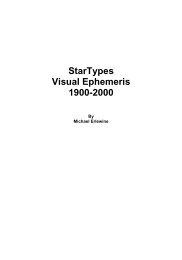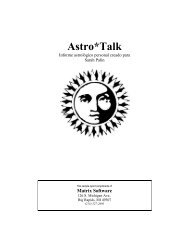The Art of Focus Stacking - Matrix Software
The Art of Focus Stacking - Matrix Software
The Art of Focus Stacking - Matrix Software
You also want an ePaper? Increase the reach of your titles
YUMPU automatically turns print PDFs into web optimized ePapers that Google loves.
Challenges in <strong>Focus</strong> <strong>Stacking</strong><br />
Challenges in <strong>Focus</strong> <strong>Stacking</strong><br />
<strong>Focus</strong> stacking has a number <strong>of</strong> distinct challenges,<br />
things to keep in mind when you are learning to use<br />
this technique, so let’s go over some <strong>of</strong> them.<br />
Near <strong>Focus</strong><br />
A continual problem I have is not having the nearest<br />
objects in focus. It is an easy mistake to make.<br />
Of course, if there is a single object I don’t miss that.<br />
But let’s say I am photographing a bunch <strong>of</strong> moss or<br />
foliage. Many times after the shoot when I am back<br />
on the computer I find that I did not get the very most<br />
front matter. It could just be the tip <strong>of</strong> the top <strong>of</strong> a few<br />
blades <strong>of</strong> grass but it more-or-less ruins the shot. So<br />
it pays to back <strong>of</strong>f until the entire field is out <strong>of</strong> focus,<br />
and then start in until the first something appears and<br />
shoot that. Some focus stackers make a rule <strong>of</strong> starting<br />
with an out-<strong>of</strong>-focus shot.<br />
With rear focus, it usually does not matter. We can just<br />
call a missed layer in the rear… bokeh.<br />
A <strong>Focus</strong> Too Far<br />
Often we try to get too much <strong>of</strong> the entire frame in focus<br />
and it can be just too far <strong>of</strong> a reach. I have learned<br />
to let the rear part <strong>of</strong> the frame remain somewhat out<br />
<strong>of</strong> focus so that it either is or resembles bokah. This<br />
brings out the subject in the foreground that is in focus<br />
all the better, which amounts to traditional photography<br />
with just a wee bit more in focus.<br />
You will get a feel for how much you can strong-arm<br />
the entire frame into focus. I find it is better to pick my<br />
battles carefully.<br />
“All-<strong>Focus</strong>” Not Always Good<br />
I also find that just because I can bring the whole<br />
frame to focus does not mean I should or that the<br />
resulting photo will look good. Full-frame focus can<br />
be disorienting, such as a case where you are looking<br />
through different layers <strong>of</strong> tree branches and lose all<br />
sense <strong>of</strong> layers and distance which is just what makes<br />
the shot interesting in the first place.<br />
<strong>Focus</strong> stacking can remove the sense <strong>of</strong> distance,<br />
since the eye is used to having a focus point and the<br />
rest <strong>of</strong> the image more-or-less out <strong>of</strong> focus. This can<br />
make for an unusual sense <strong>of</strong> space and spaciousness<br />
which can either enhance a photo or make it<br />
seem claustrophobic. Some scenes are not worth<br />
stacking.<br />
Movement<br />
<strong>Focus</strong> <strong>Stacking</strong> is primarily for still life photography,<br />
where nothing is moving. Movement causes artifacts<br />
in the finished photo that (usually) cannot be remedied,<br />
with the result that the photo is not considered<br />
satisfactory. This is not say that focus stacking should<br />
not be used for nature photography with live subjects,<br />
but just that you want to catch your critters at rest,<br />
holding a pose long enough for you to shoot a few<br />
frames at different focus points.<br />
<strong>Focus</strong> stacking with moving subjects can make for interesting<br />
impressionistic or expressionistic photos, but<br />
most <strong>of</strong> these would fall into the category <strong>of</strong> artistic<br />
experimentation rather than nature photography.<br />
What’s Missing?<br />
Usually you won’t know until you are home on the<br />
computer processing the shots, but here is the rule<br />
<strong>of</strong> thumb: unless you are shooting 30-40 shots on a<br />
focusing rack setup or shooting traditional (one plane<br />
<strong>of</strong> focus), something will be left out, somewhere. <strong>The</strong><br />
skill comes in choosing what you want in focus and<br />
what if left out will never be missed.<br />
Just about every stacked photo I have made has<br />
weak or missing spots, if not outright blatant artifacts.<br />
I generally ignore those who insist every speck has<br />
to be in focus or you are a lousy photographer. That’s<br />
asking too much and is by definition impossible without<br />
shooting hundreds <strong>of</strong> photos. Every other possibility<br />
has one kind <strong>of</strong> flaw or another. With focus stacking,<br />
you just have to pick your battles.<br />
And as I like to say, focus stacking (at least the kind I<br />
do) is at heart impressionistic, meaning that I as the<br />
photographer choose what to have in focus and what<br />
to ignore. <strong>The</strong> result (like all photographs) is my impression<br />
<strong>of</strong> the subject, the sense <strong>of</strong> it as I see it. Like<br />
HDR and other newer techniques, focus stacking is<br />
just another way to present an impression <strong>of</strong> what you<br />
see, in this case by playing with focus. Further on I<br />
will illustrate these various problems.<br />
Camera Modes<br />
Most cameras nowadays <strong>of</strong>fer you the option <strong>of</strong> several<br />
shooting modes, typically:<br />
Program Mode<br />
<strong>The</strong> camera does everything for you and decides<br />
what is your best shot.<br />
Shutter Priority Mode<br />
You set the shutter to what you need, and the camera<br />
does the rest. For example, in sports events, you<br />
need a high (fast) shutter speed to capture the action,<br />
while in still life photography, you can use a much<br />
lower shutter speed.<br />
Aperture Priority Mode<br />
Here you set the aperture yourself to gather more or<br />
less light, and let the camera do the rest.<br />
Manual Mode<br />
In this mode, the photographer sets everything, the<br />
shutter speed, the aperture, and the focus. THIS is<br />
the mode I generally use and recommend, although<br />
you can use any <strong>of</strong> the above with the exception <strong>of</strong><br />
auto-focus. Setting aperture, shutter speed, and ISO<br />
limits becomes natural very quickly.<br />
79

















